Motorola XPR 4580 User Manual
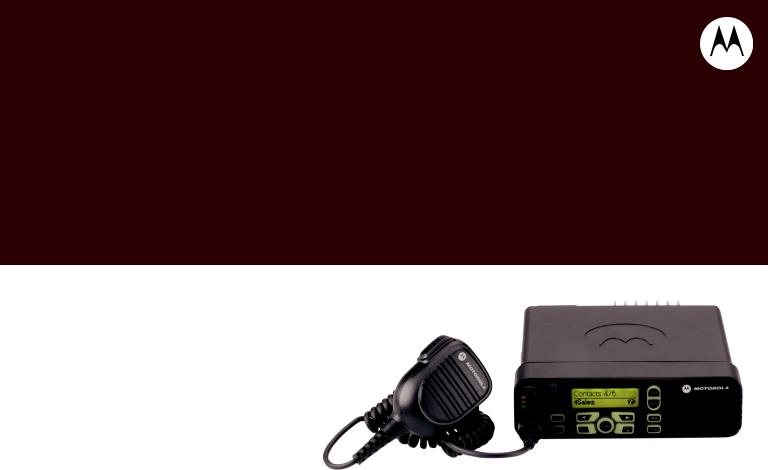
PROFESSIONAL DIGITAL TWO-WAY RADIO SYSTEM
MOTOTRBO™
XPR™ 4550 / XPR™ 4580 DISPLAY MOBILE
USER GUIDE

Declaration of Conformity
This declaration is applicable to your radio only if your radio is labeled with the FCC logo shown below.
DECLARATION OF CONFORMITY
Per FCC CFR 47 Part 2 Section 2.1077(a)
Responsible Party
Name: Motorola Solutions, Inc.
Address: 1301 East Algonquin Road, Schaumburg, IL 60196-1078, U.S.A. Phone Number: 1-800-927-2744
Hereby declares that the product: Model Name: XPR 4550/XPR 4580
conforms to the following regulations:
FCC Part 15, subpart B, section 15.107(a), 15.107(d) and section 15.109(a)
Class B Digital Device
As a personal computer peripheral, this device complies with Part 15 of the FCC Rules. Operation is subject to the following two conditions:
1.This device may not cause harmful interference, and
2.This device must accept any interference received, including interference that may cause undesired operation.
Conformity of Declaration
i
English

Declaration of Conformity
ii
Note: This equipment has been tested and found to comply with the limits for a Class B digital device, pursuant to part 15 of the FCC Rules. These limits are designed to provide reasonable protection against harmful interference in a residential installation. This equipment generates, uses and can radiate radio frequency energy and, if not installed and used in accordance with the instructions, may cause harmful interference to radio communications. However, there is no guarantee that interference will not occur in a particular installation.
If this equipment does cause harmful interference to radio or television reception, which can be determined by turning the equipment off and on, the user is encouraged to try to correct the interference by one or more of the following measures:
•Reorient or relocate the receiving antenna.
•Increase the separation between the equipment and receiver.
•Connect the equipment into an outlet on a circuit different from that to which the receiver is connected.
•Consult the dealer or an experienced radio/TV technician for help.
English

Contents
This User Guide contains all the information you need to use the MOTOTRBO XPR Series Digital Mobile Radios.
Declaration of Conformity . . . . . . . . . . . . . . . . . . . . . i Notes . . . . . . . . . . . . . . . . . . . . . . . . . . . . . . . . . . . . viii
Important Safety Information . . . . . . . . . . . . . . . . . ix
Product Safety and RF Exposure Compliance . . .ix
Software Version . . . . . . . . . . . . . . . . . . . . . . . . . . . ix Computer Software Copyrights . . . . . . . . . . . . . . . . x
Getting Started . . . . . . . . . . . . . . . . . . . . . . . . . . . . . . 1
How to Use This User Guide . . . . . . . . . . . . . . . . . . 1 What Your Dealer/System Administrator
Can Tell You . . . . . . . . . . . . . . . . . . . . . . . . . . . . . . . 1 Powering Up the Radio . . . . . . . . . . . . . . . . . . . . . . . 2 Adjusting the Volume . . . . . . . . . . . . . . . . . . . . . . . . 2
Identifying Radio Controls . . . . . . . . . . . . . . . . . . . . 3
Radio Controls . . . . . . . . . . . . . . . . . . . . . . . . . . . . . 3 Programmable Buttons . . . . . . . . . . . . . . . . . . . . . . . 4 Assignable Radio Functions . . . . . . . . . . . . . . . . . 4 Assignable Settings/Utility Functions . . . . . . . . . . . 5
Accessing the Programmed Functions . . . . . . . . . . . 6
Push-To-Talk (PTT) Button . . . . . . . . . . . . . . . . . . . . 6
Switching Between Conventional Analog and Digital
Mode . . . . . . . . . . . . . . . . . . . . . . . . . . . . . . . . . . . . . 7
Capacity Plus . . . . . . . . . . . . . . . . . . . . . . . . . . . . . . 7
Identifying Status Indicators . . . . . . . . . . . . . . . . . . . 8
Display Icons . . . . . . . . . . . . . . . . . . . . . . . . . . . . . . . 8
Call Icons . . . . . . . . . . . . . . . . . . . . . . . . . . . . . . . . . 9
Sent Item Icons . . . . . . . . . . . . . . . . . . . . . . . . . . . 10
LED Indicators . . . . . . . . . . . . . . . . . . . . . . . . . . . . 10
Audio Tones . . . . . . . . . . . . . . . . . . . . . . . . . . . . . . 11
Indicator Tones . . . . . . . . . . . . . . . . . . . . . . . . . . . . 12
Receiving and Making Calls . . . . . . . . . . . . . . |
. . . . 12 |
Selecting a Site . . . . . . . . . . . . . . . . . . . . . . . |
. . . . 12 |
Selecting a Zone . . . . . . . . . . . . . . . . . . . . . . . |
. . . . 13 |
Selecting a Radio Channel, Subscriber Alias or ID, or |
|
Group Alias or ID . . . . . . . . . . . . . . . . . . . . . . |
. . . . 13 |
Receiving and Responding to a Radio Call . . |
. . . . 14 |
Receiving and Responding to a Group Call . |
. . . . 14 |
Receiving and Responding to a Private Call |
. . . 15 |
Receiving an All Call . . . . . . . . . . . . . . . . . . |
. . . . 16 |
Receiving and Responding to a Phone Call |
. . . . 17 |
Phone Call as Private Call . . . . . . . . . . . . . |
. . . 17 |
Phone Call as Group Call . . . . . . . . . . . . . . |
. . . 17 |
Contents
iii
English

Contents
iv
Phone Call as All Call . . . . . . . . . . . . . . . . . . . |
18 |
Making a Radio Call . . . . . . . . . . . . . . . . . . . . . . . . 18 Making a Call with the Channel Rocker . . . . . . . 19 Making a Group Call . . . . . . . . . . . . . . . . . . . . 19 Making a Private Call . . . . . . . . . . . . . . . . . . . 20 Making an All Call . . . . . . . . . . . . . . . . . . . . . . 21
Making a Group or Private Call with the One Touch |
|
Access Button . . . . . . . . . . . . . . . . . . . . . . . . . . |
21 |
Stopping a Radio Call . . . . . . . . . . . . . . . . . . . . . . |
22 |
Talkaround . . . . . . . . . . . . . . . . . . . . . . . . . . . . . . . 23
Permanent Monitor . . . . . . . . . . . . . . . . . . . . . . . . . 23
Advanced Features . . . . . . . . . . . . . . . . . . . . . . . . . 24
Radio Check . . . . . . . . . . . . . . . . . . . . . . . . . . . . . |
24 |
Sending a Radio Check . . . . . . . . . . . . . . . . . . . 24
Remote Monitor . . . . . . . . . . . . . . . . . . . . . . . . . . . 26
Initiating Remote Monitor . . . . . . . . . . . . . . . . . . 26
Stopping Remote Monitor . . . . . . . . . . . . . . . . . . 27
Scan Lists . . . . . . . . . . . . . . . . . . . . . . . . . . . . . . . . 28
Viewing an Entry in the Scan List . . . . . . . . . . . . 28
Editing the Scan List . . . . . . . . . . . . . . . . . . . . . . 28
Adding a New Entry to the Scan List . . . . . . . . 28
Deleting an Entry from the Scan List . . . . . . . . 29
Setting and Editing Priority for an Entry in the Scan
List . . . . . . . . . . . . . . . . . . . . . . . . . . . . . . . . . . 29
Scan . . . . . . . . . . . . . . . . . . . . . . . . . . . . . . . . . . . . 30
Starting and Stopping Scan . . . . . . . . . . . . . . |
. . 30 |
Responding to a Transmission During a Scan |
. . 31 |
Deleting a Nuisance Channel . . . . . . . . . . . . . |
. . 31 |
Restoring a Nuisance Channel . . . . . . . . . . . . |
. . 32 |
Contacts Settings . . . . . . . . . . . . . . . . . . . . . . . |
. . 32 |
Making a Group Call from Contacts . . . . . . . . |
. . 33 |
Making a Private Call from Contacts . . . . . . . |
. . 34 |
Assigning an Entry to a Programmable |
|
Number Key . . . . . . . . . . . . . . . . . . . . . . . . . . |
. . 35 |
Removing the Association between Entry and |
|
Programmable Number Key . . . . . . . . . . . . . |
. . 36 |
Call Indicator Settings . . . . . . . . . . . . . . . . . . . . . |
. 36 |
Activating and Deactivating Call Ringers for Private |
|
Calls . . . . . . . . . . . . . . . . . . . . . . . . . . . . . . . . . |
. 36 |
Activating and Deactivating Call Ringers for Text |
|
Messaging . . . . . . . . . . . . . . . . . . . . . . . . . . . . |
. 37 |
Activating and Deactivating Call Ringers for |
|
Telemetry Status with Text . . . . . . . . . . . . . . . |
. 37 |
Assigning Ring Styles . . . . . . . . . . . . . . . . . . . |
. 38 |
Escalating Alarm Tone Volume . . . . . . . . . . . . . |
. 38 |
Call Log Features . . . . . . . . . . . . . . . . . . . . . . . . |
. 39 |
Viewing Recent Calls . . . . . . . . . . . . . . . . . . . . |
. 39 |
Missed Call Screen . . . . . . . . . . . . . . . . . . . . . . |
. 39 |
Deleting a Call from a Call List . . . . . . . . . . . . . |
. 40 |
Call Alert Operation . . . . . . . . . . . . . . . . . . . . . . . |
. 40 |
English

Receiving and Responding to a Call Alert . . . . . . 40 Making a Call Alert from the Contacts List . . . . . . 41 Making a Call Alert with the One Touch Access Button 41
Emergency Operation . . . . . . . . . . . . . . . . . . . . . . . 42 Receiving an Emergency Alarm . . . . . . . . . . . . . 42 Responding to an Emergency Alarm . . . . . . . . . . 43 Sending an Emergency Alarm . . . . . . . . . . . . . . . 44
Sending an Emergency Alarm with Call . . . . . . . |
44 |
Sending an Emergency Alarm with Voice to |
|
Follow . . . . . . . . . . . . . . . . . . . . . . . . . . . . . . . . . |
45 |
Reinitiating an Emergency Mode . . . . . . . . . . . . . |
46 |
Exiting Emergency Mode . . . . . . . . . . . . . . . . . . . |
46 |
Text Messaging Features . . . . . . . . . . . . . . . . . . . |
47 |
Sending a Quick Text Message . . . . . . . . . . . . . . 47 Sending a Quick Text Message with the One Touch Access Button . . . . . . . . . . . . . . . . . . . . . . . . . . . 47 Managing Text Messages in the Drafts Folder . . 48 Viewing a Saved Text Message . . . . . . . . . . . . 48 Deleting a Saved Text Message from Drafts . . 48 Managing Fail-to-Send Text Messages . . . . . . . . 49 Resending a Text Message . . . . . . . . . . . . . . . 49 Forwarding a Text Message . . . . . . . . . . . . . . . 49 Managing Sent Text Messages . . . . . . . . . . . . . . 50 Viewing a Sent Text Message . . . . . . . . . . . . . 50
Sending a Sent Text Message . . . . . . . . . . . . . 50 Deleting All Sent Text Messages from Sent Items 52
Receiving a Text Message . . . . . . . . . . . . . . . . . 52 Reading a Text Message . . . . . . . . . . . . . . . . . . . 52 Managing Received Text Messages . . . . . . . . . . 53 Viewing a Text Message from the Inbox . . . . . 53 Viewing a Telemetry Status Text Message from the Inbox . . . . . . . . . . . . . . . . . . . . . . . . . . . . . . . . . 54 Replying to a Text Message with Quick Text . . 54 Deleting a Text Message from the Inbox . . . . . 55 Deleting All Text Messages from the Inbox . . . 55 Privacy . . . . . . . . . . . . . . . . . . . . . . . . . . . . . . . . . . 56 IP Site Connect . . . . . . . . . . . . . . . . . . . . . . . . . . . 57 Starting an Automatic Site Search . . . . . . . . . . . . 57 Stopping an Automatic Site Search . . . . . . . . . . . 58 Starting a Manual Site Search . . . . . . . . . . . . . . . 58 Security . . . . . . . . . . . . . . . . . . . . . . . . . . . . . . . . . 59 Radio Disable . . . . . . . . . . . . . . . . . . . . . . . . . . . 59 Radio Enable . . . . . . . . . . . . . . . . . . . . . . . . . . . . 60 Lone Worker . . . . . . . . . . . . . . . . . . . . . . . . . . . . . . 61 Third Party Peripherals Connection Modes . . . . . . 62 Utilities . . . . . . . . . . . . . . . . . . . . . . . . . . . . . . . . . . 63 Setting the Squelch Level . . . . . . . . . . . . . . . . . . 63 Setting the Power Level . . . . . . . . . . . . . . . . . . . . 63
Contents
v
English

Contents
vi
Turning the Option Board Feature(s) On or Off . 64 Turning the Voice Operating Transmission (VOX) Feature On or Off . . . . . . . . . . . . . . . . . . . . . . . . 64 Turning the Public Address System On or Off . . 65 Turning the External Public Address System On
or Off . . . . . . . . . . . . . . . . . . . . . . . . . . . . . . . . . . 65
Controlling the Display Backlight . . . . . . . |
. . . . . 65 |
Turning Horns/Lights On or Off . . . . . . . . . |
. . . . . 66 |
Turning the Radio Tones/Alerts On or Off |
. . . . . 66 |
Setting the Tone Alert Volume Offset Level . . . . 67 Turning the Talk Permit Tone On or Off . . . . . . . 67 Turning the Power Up Alert Tone On or Off . . . . 68 Setting the Text Message Alert Tone . . . . . . . . . 68 Turning the LED Indicators On or Off . . . . . . . . . 69 Turning the Introduction Screen On or Off . . . . . 69 Accessing General Radio Information . . . . . . . . 70
Checking the Radio Alias and ID . . . . . . . . . . 70 Checking the Firmware Version . . . . . . . . . . . . 71 Checking the Codeplug Version . . . . . . . . . . . 71
Keypad Microphone Features . . . . . . . . . . . . . . . . |
71 |
Using the Keypad . . . . . . . . . . . . . . . . . . . . . . . . . . |
72 |
Turning Keypad Tones On or Off . . . . . . . . . . . . |
73 |
Additional Advanced Features . . . . . . . . . . . . . . . . |
73 |
Selecting a Zone by Alias Search . . . . . . . . . . . . |
73 |
Initiating a Radio Check by Manual Dial . . . . . . |
74 |
Initiating Remote Monitor by Manual Dial |
. . . . . 74 |
Making a Private Call by Manual Dial . . . |
. . . . . 75 |
Making a Phone Call by Manual Dial . . . . . |
. . . . 76 |
Making a Phone Call with the One Touch Access |
|
Button . . . . . . . . . . . . . . . . . . . . . . . . . . . . . |
. . . . 78 |
Making a Group, Private or All Call with the |
|
Programmable Number Key . . . . . . . . . . . |
. . . . 79 |
Making a Phone Call with the Programmable Phone Button . . . . . . . . . . . . . . . . . . . . . . . . . . . . . . . . . 80
Making a Phone Call from Contacts . . . . . . . . . |
82 |
Making a Group, Private, Phone or All Call by Alias Search . . . . . . . . . . . . . . . . . . . . . . . . . . . . . . . . 84 Viewing an Entry in the Scan List by Alias Search 85 Editing the Scan List by Alias Search . . . . . . . . . 85 Adding a New Entry to the Scan List . . . . . . . . 85 Deleting an Entry from the Scan List . . . . . . . . 86 Setting and Editing Priority for an Entry in the Scan List . . . . . . . . . . . . . . . . . . . . . . . . . . . . . . . . . . 87 Storing an Alias or ID from the Missed Call List . 87
Making a Call Alert by Manual Dial . . . . . . . . . . |
88 |
Text Messaging . . . . . . . . . . . . . . . . . . . . . . . . . . . 88 Writing and Sending a Text Message . . . . . . . . . 88 Replying to Text Messages from the Inbox . . . . . 89 Editing a Quick Text Message . . . . . . . . . . . . . . 90 Accessing the Drafts Folder . . . . . . . . . . . . . . . . 91
English

Editing and Sending a Saved Text Message . . 91
Managing Fail-to-Send Text Messages . . . . . . . . 92
Forwarding a Text Message by Manual Dial . . 92
Editing a Text Message . . . . . . . . . . . . . . . . . . 93
Dual Tone Multi Frequency (DTMF) . . . . . . . . . . . . 93
Security . . . . . . . . . . . . . . . . . . . . . . . . . . . . . . . . . 94
Radio Disable via Manual Dial . . . . . . . . . . . . . . . 94
Radio Enable via Manual Dial . . . . . . . . . . . . . . . 94
Password Lock Features . . . . . . . . . . . . . . . . . . . . 95
Accessing the Radio from Password . . . . . . . . . . 95
Unlocking the Radio from Locked State . . . . . . . 96
Turning the Password Lock On or Off . . . . . . . . . 96
Changing the Password . . . . . . . . . . . . . . . . . . . . 97
Accessories . . . . . . . . . . . . . . . . . . . . . . . . . . . . . . . 98
Antennas . . . . . . . . . . . . . . . . . . . . . . . . . . . . . . . . . 98
Audio . . . . . . . . . . . . . . . . . . . . . . . . . . . . . . . . . . . 100
Cables . . . . . . . . . . . . . . . . . . . . . . . . . . . . . . . . . . 100
Desktop Accessories . . . . . . . . . . . . . . . . . . . . . . 100
Mounting Kits . . . . . . . . . . . . . . . . . . . . . . . . . . . . 100
Remote Mount Adaptor Kits . . . . . . . . . . . . . . . . . 101
Speakers . . . . . . . . . . . . . . . . . . . . . . . . . . . . . . . . 101
Miscellaneous Accessories . . . . . . . . . . . . . . . . . . 101
Appendix: Maritime Radio Use in the VHF Frequency
Range . . . . . . . . . . . . . . . . . . . . . . . . . . . . . . . . . . . |
102 |
|
|
Special Channel Assignments . . . . . . . . . . . . . . . |
102 |
Contents |
|
Emergency Channel . . . . . . . . . . . . . . . . . . . . . |
102 |
||
Non-Commercial Call Channel |
102 |
||
|
|||
Operating Frequency Requirements . . . . . . . . . . . |
103 |
|
|
Limited Warranty . . . . . . . . . . . . . . . . . . . . . . . . . . |
105 |
|
|
Notes . . . . . . . . . . . . . . . . . . . . . . . . . . . . . . . . . . . . |
108 |
|
vii
English

Notes
Notes
viii
English

Important Safety Information
Product Safety and RF Exposure Compliance
!
C a u t i o n
Before using this product, read the operating instructions for safe usage contained in the Product Safety and RF Exposure booklet enclosed with your radio.
ATTENTION!
This radio is restricted to occupational use only to satisfy FCC RF energy exposure requirements.
Before using this product, read the RF energy awareness information and operating instructions in the Product Safety and RF Exposure booklet enclosed with your radio (Motorola Publication part number 6881095C99) to ensure compliance with RF energy exposure limits.
For a list of Motorola-approved antennas and other accessories, visit the following website:
http://www.motorolasolutions.com/governmentandenterprise
|
|
|
|
|
|
|
|
|
|
|
|
|
|
|
|
|
|
|
|
|
|
|
|
|
|
|
|
|
|
|
|
|
|
|
|
|
|
|
|
|
|
|
|
|
|
|
|
|
|
|
|
|
|
|
|
|
|
|
|
|
|
|
|
|
|
|
|
|
|
|
|
|
|
|
|
|
|
|
|
|
|
|
|
|
Software Version |
|
|
Important |
|||||||||||||||||||||||||||||||||||||||||||||||||||||||||||||||||||||||||||||||||
All the features described in the following sections are |
|
|
||||||||||||||||||||||||||||||||||||||||||||||||||||||||||||||||||||||||||||||||||
|
|
|
||||||||||||||||||||||||||||||||||||||||||||||||||||||||||||||||||||||||||||||||||
supported by the radio's software version R01.08.00 or |
|
|
|
|||||||||||||||||||||||||||||||||||||||||||||||||||||||||||||||||||||||||||||||||
later. |
|
|
|
|||||||||||||||||||||||||||||||||||||||||||||||||||||||||||||||||||||||||||||||||
See Checking the Firmware Version on page 71 to |
|
|
|
|||||||||||||||||||||||||||||||||||||||||||||||||||||||||||||||||||||||||||||||||
determine your radio's software version. |
|
|
InformationSafety |
|||||||||||||||||||||||||||||||||||||||||||||||||||||||||||||||||||||||||||||||||
Please check with your dealer or system administrator |
|
|
||||||||||||||||||||||||||||||||||||||||||||||||||||||||||||||||||||||||||||||||||
|
|
|
||||||||||||||||||||||||||||||||||||||||||||||||||||||||||||||||||||||||||||||||||
for more details of all the features supported. |
|
|
|
|||||||||||||||||||||||||||||||||||||||||||||||||||||||||||||||||||||||||||||||||
ix
English

Computer Software Copyrights
|
The Motorola products described in this manual may |
|
|
include copyrighted Motorola computer programs stored |
|
|
in semiconductor memories or other media. Laws in the |
|
|
United States and other countries preserve for Motorola |
|
Copyrights |
certain exclusive rights for copyrighted computer |
|
programs including, but not limited to, the exclusive right |
||
to copy or reproduce in any form the copyrighted |
||
|
||
|
computer program. Accordingly, any copyrighted |
|
|
Motorola computer programs contained in the Motorola |
|
|
products described in this manual may not be copied, |
|
|
reproduced, modified, reverse-engineered, or distributed |
|
Software |
in any manner without the express written permission of |
|
Motorola. Furthermore, the purchase of Motorola |
||
|
||
|
products shall not be deemed to grant either directly or by |
|
|
implication, estoppel, or otherwise, any license under the |
|
|
copyrights, patents or patent applications of Motorola, |
|
Computer |
except for the normal non-exclusive license to use that |
|
arises by operation of law in the sale of a product. |
||
|
x
The AMBE+2TM voice coding Technology embodied in this product is protected by intellectual property rights including patent rights, copyrights and trade secrets of Digital Voice Systems, Inc.
This voice coding Technology is licensed solely for use within this Communications Equipment. The user of this Technology is explicitly prohibited from attempting to decompile, reverse engineer, or disassemble the Object Code, or in any other way convert the Object Code into a human-readable form.
U.S. Pat. Nos. #5,870,405, #5,826,222, #5,754,974, #5,701,390, #5,715,365, #5,649,050, #5,630,011, #5,581,656, #5,517,511, #5,491,772, #5,247,579, #5,226,084 and #5,195,166.
English

Getting Started
Take a moment to review the following:
How to Use This User Guide. . . . . . . . . . . . . . . . . . . . . page 1
What Your Dealer/System Administrator
Can Tell You. . . . . . . . . . . . . . . . . . . . . . . . . . . . . . . . page 1 Powering Up the Radio . . . . . . . . . . . . . . . . . . . . . . . . . page 2 Adjusting the Volume. . . . . . . . . . . . . . . . . . . . . . . . . . . page 2
 How to Use This User Guide
How to Use This User Guide
This User Guide covers the basic operation of the MOTOTRBO Mobiles.
However, your dealer or system administrator may have customized your radio for your specific needs. Check with your dealer or system administrator for more information.
Throughout this publication, the icons below are used to indicate features supported in either the conventional Analog
mode or conventional Digital mode:
Indicates a conventional Analog Mode-Only feature.
Indicates a conventional Digital Mode-Only feature.
For features that are available in both Analog and Digital modes, no icon is shown.
Selected features are also available on the single-site trunking |
Getting |
||
mode, Capacity Plus. See Capacity Plus on page 7 for more |
|||
|
|||
information. |
|
||
|
What Your Dealer/System Administrator |
Started |
|
|
|||
You can consult your dealer or system administrator about the |
|||
|
Can Tell You |
|
|
following: |
|
||
•Is your radio programmed with any preset conventional channels?
•Which buttons have been programmed to access other features?
•What optional accessories may suit your needs?
1
English
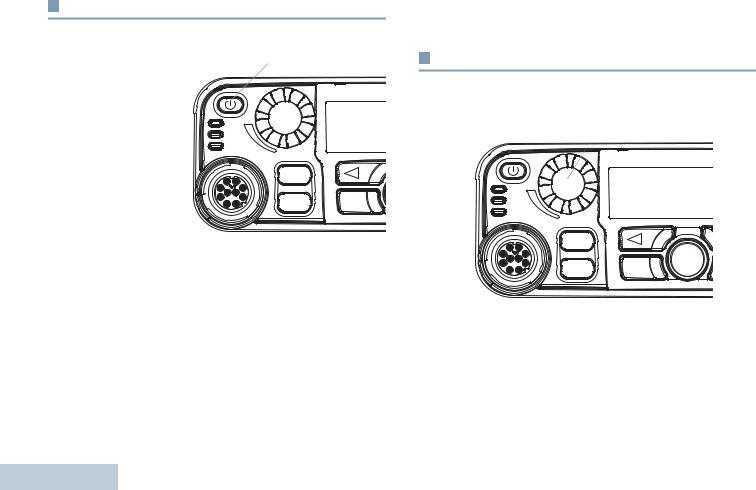
Getting Started
2
Powering Up the Radio
Press the On/Off
Button briefly. You see
On/Off Button
Motorola and MOTOTRBO (TM) on the
radio’s display momentarily, followed
by Motorola once more.
The green LED blinks and the Home screen lights up if the backlight setting is set to turn on automatically.
P1
P2
MENU
NOTE: The Home screen does not light up during a power up if the LED indicators are disabled (see Turning the LED Indicators On or Off on page 69).
A brief tone sounds, indicating that the power up test is successful.
NOTE: There is no power up tone if the radio tones/alerts function is disabled (see Turning the Radio Tones/ Alerts On or Off on page 66).
If your radio does not power up, contact your dealer.
To turn off the radio, press and hold the On/Off Button until you see Powering Down on the radio’s display.
Adjusting the Volume
To increase the volume, turn the Volume Knob clockwise.
Volume Knob
P1
P2 MENU OK
To decrease the volume, turn this knob counterclockwise.
NOTE: Your radio can be programmed to have a minimum volume offset where the volume level cannot be turned down fully. Check with your dealer or system administrator for more information.
English

Identifying Radio Controls
Take a moment to review the following:
Radio Controls. . . . . . . . . . . . . . . . . . . . . . . . . . . . . . . . page 3 Programmable Buttons . . . . . . . . . . . . . . . . . . . . . . . . . page 4 Accessing the Programmed Functions . . . . . . . . . . . . . page 6 Push-To-Talk (PTT) Button . . . . . . . . . . . . . . . . . . . . . . page 6
Switching Between Conventional Analog and
Digital Mode . . . . . . . . . . . . . . . . . . . . . . . . . . . . . . . . page 7 Capacity Plus. . . . . . . . . . . . . . . . . . . . . . . . . . . . . . . . . page 7
 Radio Controls
Radio Controls
1On/Off Button
2Volume Knob
3Front Button P1*
4Display
5Channel Rocker
6Speaker
1 |
2 |
3 |
|
4 |
|
5 |
6 |
|
|
|
|
|
|
CH+ |
|
|
|
|
|
|
|
CH - |
|
|
|
P1 |
|
|
|
P3 |
|
|
|
P2 |
MENU |
OK |
BACK |
P4 |
|
|
|
|
|
|
|
||
12 |
11 |
10 |
|
9 |
8 |
7 |
|
7Front Button P3*
8Front Button P4*
9Menu Navigation Buttons
10Front Button P2*
11Accessory Connector
12LED Indicators
*These buttons are programmable.
Controls Radio Identifying
3
English

Identifying Radio Controls
4
 Programmable Buttons
Programmable Buttons
Your dealer can program the programmable buttons as shortcuts to radio functions or up to a maximum of six (6) preset channels/groups depending on the duration of a button press:
•Short press – Pressing and releasing rapidly (0.05 seconds).
•Long press – Pressing and holding for the programmed duration (between 1.00 second and 3.75 seconds).
•Hold down – Keeping the button pressed.
NOTE: The programmed duration of a button press is applicable for all assignable radio/utility functions or settings. See Emergency Operation on page 42 for more information on the programmed duration of the
Emergency button.
Assignable Radio Functions
Contacts – Provides direct access to the Contacts list.
Emergency – Depending on the programming, initiates or cancels an emergency alarm or call.
Ext PA On/Off – Toggles the audio routing between the connected public address (PA) loudspeaker amplifier and the radio’s internal public address (PA) system.
Manual Site Roam*  – Starts the manual site search.
– Starts the manual site search.
Manual Dial – Depending on the programming, initiates a Private or Phone Call by keying in any subscriber ID or phone number. Only available with a keypad microphone.
Nuisance Channel Delete* – Temporarily removes an unwanted channel, except for the Selected Channel, from the scan list. The Selected Channel refers to the user’s selected zone/channel combination from which scan is initiated.
One Touch Access – Directly initiates a predefined Private, Phone or Group Call, a Call Alert or a Quick Text message, or returns the user to a preset channel.
Option Board Feature – Toggles option board features on or off for option board-enabled channels.
PA On/Off – Toggles the radio’s internal public address (PA) system on or off.
Permanent Monitor* – Monitors a selected channel for all radio traffic until function is disabled.
Phone  – Provides direct access to the Phone Contacts list.
– Provides direct access to the Phone Contacts list.
Privacy  – Toggles privacy on or off.
– Toggles privacy on or off.
Radio Alias and ID – Provides radio alias and ID.
Radio Check  – Determines if a radio is active in a system.
– Determines if a radio is active in a system.
Radio Enable  – Allows a target radio to be remotely enabled.
– Allows a target radio to be remotely enabled.
* Not applicable in Capacity Plus
English

Radio Disable  – Allows a target radio to be remotely disabled.
– Allows a target radio to be remotely disabled.
Remote Monitor  – Turns on the microphone of a target radio without it giving any indicators.
– Turns on the microphone of a target radio without it giving any indicators.
Repeater/Talkaround* – Toggles between using a repeater and communicating directly with another radio.
Scan* – Toggles scan on or off.
Site Lock On/Off*  – Toggles the automatic site roam on or off.
– Toggles the automatic site roam on or off.
Telemetry Control  – Controls the Output Pin on a local or remote radio.
– Controls the Output Pin on a local or remote radio.
Text Message  – Selects the text message menu.
– Selects the text message menu.
Transmit Interrupt Remote Dekey |
– Stops the |
transmission of a remote monitored radio without giving any indicators, or an ongoing interruptible call to free the channel.
Voice Operating Transmission (VOX) – Toggles VOX on or off.
Zone – Allows selection from a list of zones.
* Not applicable in Capacity Plus
Assignable Settings/Utility Functions
All Tones/Alerts – Toggles all tones on or off. |
Identifying |
||
Backlight – Controls the backlight intensity. |
|||
|
|||
Horns/Lights – Toggles horns and lights feature on or off. |
|
||
Power Level – Toggles transmit power level between high and |
|
||
low. |
|
|
|
Squelch |
– Toggles squelch level between normal and |
ControlsRadio |
|
tight. |
|
||
|
|
||
5
English
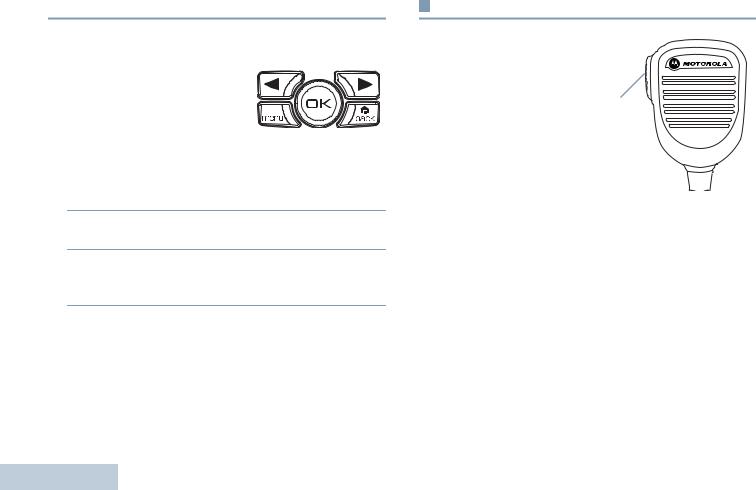
Identifying Radio Controls
6
 Accessing the Programmed Functions
Accessing the Programmed Functions
You can access various radio functions through one of the following ways:
•A short or long press of the relevant programmable buttons.
OR
• Use the Menu Navigation Buttons as follows:
1To access the menu, press the Sbutton. Press the appropriate Menu Scroll button (Por Q) to access the menu functions.
2To select a function or enter a sub-menu, press the N button.
3To go back one menu level, or to return to the previous screen, press the Rbutton. Long press the Rbutton to return to the Home screen.
The Menu Navigation Buttons are also available on a keypad microphone (see Using the Keypad on page 72).
NOTE: Your radio automatically exits the menu after a period of inactivity and returns to your Home screen.
Push-To-Talk (PTT) Button
The PTT button on the side of the microphone serves two basic purposes:
• While a call is in progress, |
PTT Button |
the PTT button allows the |
|
radio to transmit to other |
|
radios in the call. |
|
Press and hold down PTT |
|
button to talk. Release the |
|
PTT button to listen. |
|
The microphone is activated when the PTT button is pressed.
•While a call is not in progress, the PTT button is used to make a new call (see Making a Radio Call on page 18).
If the Talk Permit Tone (see Turning the Talk Permit Tone On or Off on page 67) or the PTT Sidetone  is enabled, wait until the short alert tone ends before talking.
is enabled, wait until the short alert tone ends before talking.
 During a call, if the Channel Free Indication feature is enabled on your radio (programmed by your dealer), you will hear a short alert tone the moment the target radio (the radio that is receiving your call) releases the PTT button, indicating the channel is free for you to respond.
During a call, if the Channel Free Indication feature is enabled on your radio (programmed by your dealer), you will hear a short alert tone the moment the target radio (the radio that is receiving your call) releases the PTT button, indicating the channel is free for you to respond.
English
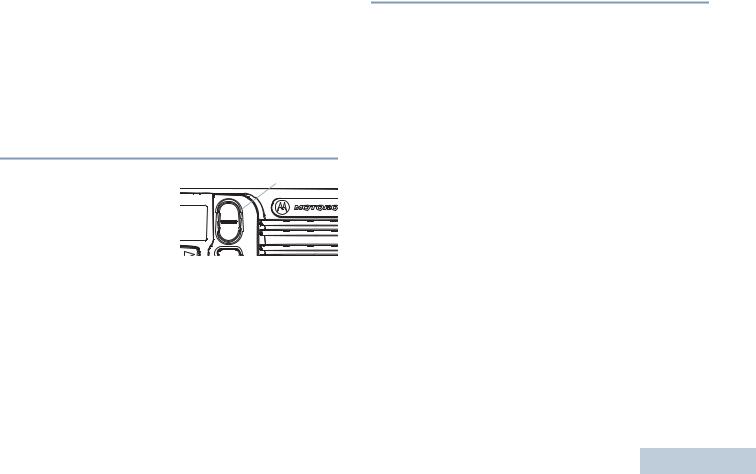
 You will also hear the Channel Free Indication tone if your call is interrupted, for example when the radio receives an Emergency Call.
You will also hear the Channel Free Indication tone if your call is interrupted, for example when the radio receives an Emergency Call.
You can turn off the Channel Free Indication tone or the
PTT Sidetone  by disabling all radio tones and alerts (see Turning the Radio Tones/Alerts On or Off on page 66).
by disabling all radio tones and alerts (see Turning the Radio Tones/Alerts On or Off on page 66).
 Switching Between Conventional Analog
Switching Between Conventional Analog
and Digital Mode
Each channel in your radio can be configured as a conventional analog or conventional digital channel. Use the Channel Rocker to switch between an analog or a digital channel.
Channel Rocker
CH+
CH -
P3
When switching from digital to analog mode, certain features are unavailable. Icons for the digital features (such as Messages) reflect this change by appearing ‘grayed out’. Disabled features are hidden in the menu.
Your radio also has features available in both analog and digital mode. However, the minor differences in the way each feature works does NOT affect the performance of your radio.
NOTE: Your radio also switches between digital and analog modes during a dual mode scan (see Scan on page 30).
 Capacity Plus
Capacity Plus
Capacity Plus is a single-site trunking configuration of the |
Identifying |
|
You can only access channel(s) with Capacity Plus via the |
||
MOTOTRBO radio system, which uses a pool of channels to |
|
|
support hundreds of users and up to 254 Groups. This feature |
|
|
allows your radio to efficiently utilize the available number of |
|
|
programmed channels while in Repeater Mode. |
|
|
Channel Rocker, while features supported in Capacity Plus can |
Radio |
|
be accessed via the menu and/or a programmable button press. |
||
|
||
Icons of features not applicable to Capacity Plus will not be |
|
|
available in the menu. You will hear a negative indicator tone if |
Controls |
|
you access a feature not applicable to Capacity Plus via a |
||
|
||
programmable button press. |
|
|
Your radio also has features that are available in both |
|
|
conventional digital mode and Capacity Plus. However, the |
|
|
minor differences in the way each feature works does NOT |
|
|
affect the performance of your radio. |
|
|
Check with your dealer or system administrator for more |
|
|
information on this system. |
|
7
English
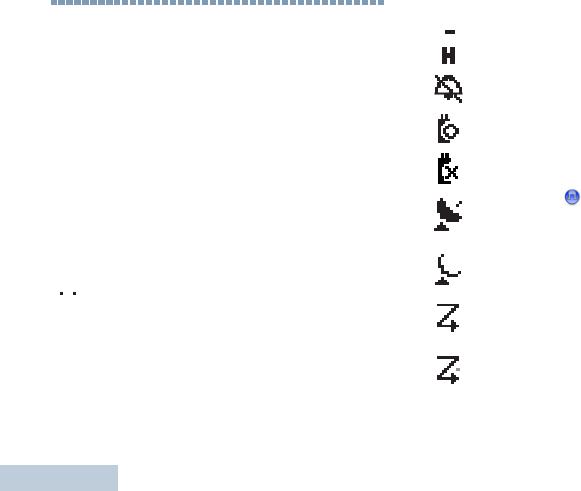
Identifying Status Indicators
|
Your radio indicates its operational status through the following: |
|||||||||
|
Display Icons. . . . . . . . . . . . . . . . . . . . . . . . . . . . . . . . |
. page 8 |
||||||||
|
Call Icons . . . . . . . . . . . . . . . . . . . . . . . . . . . . . . . . . . |
. page 9 |
||||||||
|
Sent Item Icons . . . . . . . . . . . . . . . . . . . . . . . . . . . . . . |
page 10 |
||||||||
|
LED Indicators. . . . . . . . . . . . . . . . . . . . . . . . . . . . . . . |
page 10 |
||||||||
Indicators |
Audio Tones . . . . . . . . . . . . . . . . . . . . . . . . . . . . . . . . |
page 11 |
||||||||
Indicator Tones . . . . . . . . . . . . . . . . . . . . . . . . . . . . . . |
page 12 |
|||||||||
|
|
|
|
|
Display Icons |
|
||||
|
|
|
|
|
|
|
||||
|
|
|
|
|
|
|
|
|
|
|
|
The liquid crystal display (LCD) of your radio shows the radio |
|||||||||
Status |
status, text entries, and menu entries. |
|
||||||||
The following are the icons that appear on the radio’s display. |
||||||||||
|
||||||||||
Identifying |
|
|
|
|
|
|
|
Received Signal Strength Indicator (RSSI) |
||
|
|
|
|
|
|
|
The number of bars displayed represents the radio |
|||
|
|
|
|
|
|
|
signal strength. Four bars indicates the strongest |
|||
|
|
|
|
|
|
|
|
|||
|
|
|
|
|
|
|
|
signal. This icon is only displayed while receiving. |
||
|
|
|
|
|
|
|
|
Monitor |
|
|
|
|
|
|
|
|
|
|
Selected channel is being monitored. |
|
|
|
|
|
|
|
|
|
|
|
||
|
|
|
|
|
|
|
|
|
|
|
8
English
Power Level
 Radio is set at Low power. or
Radio is set at Low power. or
Radio is set at High power.
Tones Disable
Tones are turned off.
Option Board
The Option Board is enabled.
Option Board Non-Function
The Option Board is disabled.
GPS Available
The GPS feature is enabled. The icon stays lit when a position fix is available.
GPS Not Available/Out of Range 
The GPS feature is enabled but is not receiving data from the satellite.
Scan*
Scan feature is activated.
Priority Scan*
Radio detects activity on channel/group designated as Priority 1 (if • is blinking) or Priority 2 (if • is steady).
* Not applicable in Capacity Plus

Unread Message
User has unread message(s) in the Inbox.
Inbox Full
User’s Inbox is full.
Emergency
Radio is in Emergency mode.
Secure
The Privacy feature is enabled.
Unsecure
The Privacy feature is disabled.
Site Roaming*
The auto roaming feature is enabled.
Talkaround*
In the absence of a repeater, radio is currently configured for direct radio to radio communication.
* Not applicable in Capacity Plus
 Call Icons
Call Icons
The following icons appear on the radio’s display during a call. |
Identifying |
||||||
These icons also appear in the Contacts list to indicate alias or |
|||||||
|
|||||||
ID type. |
|
||||||
|
|
|
|
|
Private Call |
|
|
|
|
|
|||||
|
|
|
|
|
Indicates a Private Call in progress. In the Contacts |
|
|
|
|
|
|
|
|
||
|
|
|
|
|
list, it indicates a subscriber alias (name) or ID |
Status |
|
|
|
||||||
|
|
|
|
|
(number). |
||
|
|
|
|
|
Group Call/All Call |
||
|
|
|
|
|
Indicates a Group Call or All Call in progress. In the |
|
|
|
|
|
|
|
|||
|
|
|
|
|
|
||
|
|
|
|
|
Contacts list, it indicates a group alias (name) or ID |
Indicators |
|
|
|
|
|
|
ID (number). |
||
|
|
|
|
|
(number). |
|
|
|
|
|
|
|
Phone Call as Private Call |
|
|
|
|
|
|
|
Indicates a Phone Call as Private Call in progress. In |
|
|
|
|
|
|
|
the Contacts list, it indicates a phone alias (name) or |
|
|
|
|
|
|
|
Phone Call as Group/All Call |
|
|
|
|
|
|
|
Indicates a Phone Call as Group/All Call in progress. |
|
|
|
|
|
|
|
In the Contacts list, it indicates a group alias (name) |
|
|
|
|
|
|
|
or ID (number). |
|
|
9
English
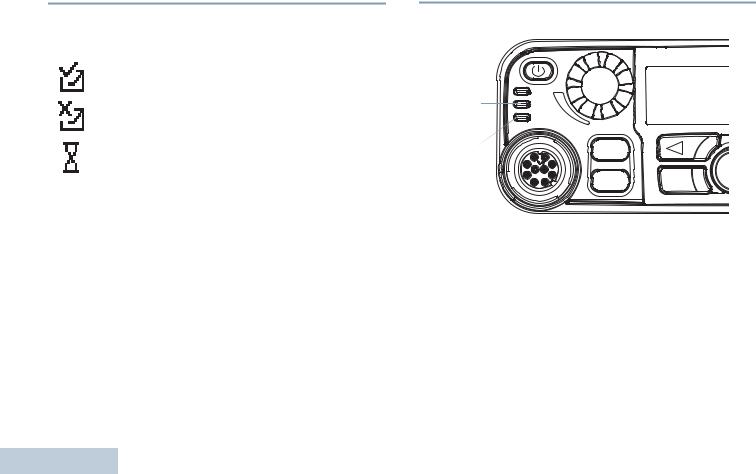
Identifying Status Indicators
10
 Sent Item Icons
Sent Item Icons 
The following icons appear at the top right corner of the radio’s display in the Sent Items folder.
Sent Successfully
The text message is sent successfully.
Send Failed
The text message cannot be sent.
In-Progress
• The text message to a group alias or ID is pending transmission.
•The text message to a subscriber alias or ID is pending transmission, followed by waiting for acknowledgement.
 LED Indicators
LED Indicators
LED indicators show the operational status of your radio.
Red
Yellow
Green |
P1 |
P2 MENU
Blinking red – Radio is receiving an Emergency transmission or has failed the self-test upon powering up.
Solid yellow – Radio is monitoring a channel.
Blinking yellow – Radio is scanning for activity or receiving a Call Alert.
Double blinking yellow – Radio is no longer connected to the repeater while in Capacity Plus, all Capacity Plus channels are currently busy or in locked state.
English
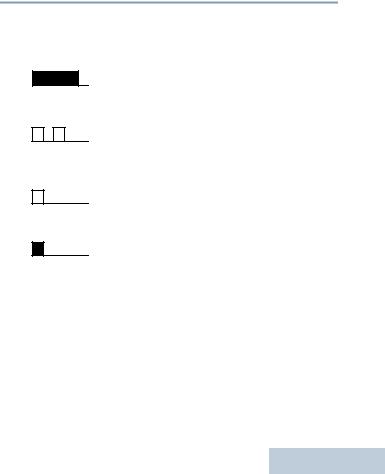
Rapidly blinking yellow – Radio is actively searching for a new site. 
Solid green – Radio is transmitting.
Blinking green – Radio is powering up, receiving a non- privacy-enabled call or data, or detecting activity over the air.
Rapidly blinking green – Radio is receiving a privacy-enabled call or data. 
NOTE: While in conventional mode, when the green LED blinks, it indicates the radio detects activity over the air. Due to the nature of the digital protocol, this activity may or may not affect the radio's programmed channel.
For Capacity Plus, there is no LED indication when the radio is detecting activity over the air.
Upon a PTT button press, if the radio is programmed for polite operation, the radio automatically determines whether a transmission is permitted via a Talk Permit or a Talk Denial tone.
 Audio Tones
Audio Tones
Alert tones provide you with audible indications of the radio’s status or the radio’s response to data received.
Continuous Tone A monotone sound. Sounds continuously until termination.
Periodic Tone Sounds periodically depending on the duration set by the radio. Tone starts, stops, and repeats itself.
Repetitive Tone A single tone that repeats itself until it is terminated by the user.
Momentary Tone Sounds only once for a short period of time defined by the radio.
Indicators Status Identifying
11
English
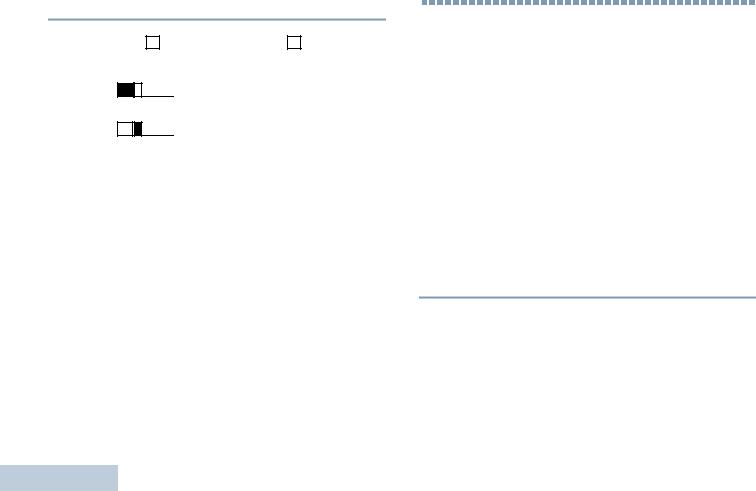
 Indicator Tones
Indicator Tones
High pitched tone |
Low pitched tone |
|
Positive Indicator Tone
Negative Indicator Tone
Receiving and Making Calls
12
Receiving and Making Calls
Once you understand how your MOTOTRBO Mobile is configured, you are ready to use your radio.
Use this navigation guide to familiarize yourself with the basic Call features:
Selecting a Site . . . . . . . . . . . . . . . . . . . . . . . . . . . . . . page 12 Selecting a Zone . . . . . . . . . . . . . . . . . . . . . . . . . . . . . page 13
Selecting a Radio Channel, Subscriber Alias or ID,
or Group Alias or ID . . . . . . . . . . . . . . . . . . . . . . . . . page 13 Receiving and Responding to a Radio Call . . . . . . . . . page 14 Making a Radio Call. . . . . . . . . . . . . . . . . . . . . . . . . . . page 18 Stopping a Radio Call . . . . . . . . . . . . . . . . . . . . . . . . . page 22 Talkaround . . . . . . . . . . . . . . . . . . . . . . . . . . . . . . . . . . page 23 Permanent Monitor . . . . . . . . . . . . . . . . . . . . . . . . . . . page 23
 Selecting a Site
Selecting a Site 
A site is a specific area where a base station is placed to provide optimal coverage for the radio.
If enabled, your radio is able to connect to different available sites via an Internet Protocol (IP) network.
See IP Site Connect on page 57 for more information.
English

 Selecting a Zone
Selecting a Zone
A zone is a group of channels. Your radio supports up to 250 zones, with a maximum of 160 channels per zone.
Use the following procedure to select a zone.
Procedure:
Press the programmed Zone button and proceed to Step 3.
OR
Follow the procedure below.
1Sto access the menu.
2Por Qto Zone and press Nto select.
3The current zone is displayed and indicated by a 9.
4Por Qto the required zone and press Nto select.
5The display shows <Zone> Selected momentarily and
returns to the selected zone screen.

 Selecting a Radio Channel, Subscriber Alias or ID, or Group Alias or ID
Selecting a Radio Channel, Subscriber Alias or ID, or Group Alias or ID
Channel Rocker
CH+
CH -
P3
OK BACK P4
Procedure:
Once the required zone is displayed (if you have multiple zones in your radio), press the Channel Rocker to select the channel, subscriber alias or ID, or group alias or ID.
OR
Press the programmed One Touch Access button to select the preset channel assigned to the button.
Calls Making and Receiving
13
English
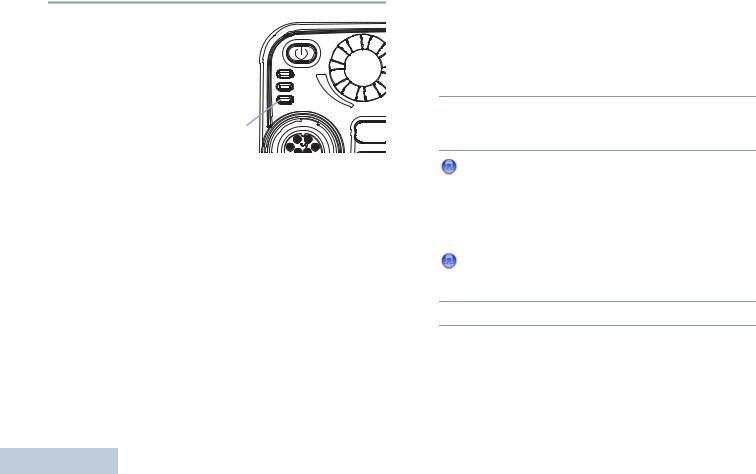
Receiving and Making Calls
14
 Receiving and Responding to a Radio Call
Receiving and Responding to a Radio Call
Once the channel, subscriber alias or ID, or group alias or ID is displayed, you can proceed to receive and respond to
calls.
The green LED lights up while the radio is transmitting and blinks when the radio is receiving.
Green |
P1 |
LED |
|
NOTE: The green LED lights up while the radio is transmitting and blinks rapidly when the radio is receiving a privacyenabled call.
To unscramble a privacy-enabled call, your radio must have the same Privacy Key, or the same Key Value and Key ID (programmed by your dealer) as the transmitting radio (the radio you are receiving the call from).
See Privacy on page 56 for more information. 
Receiving and Responding to a Group Call
To receive a call from a group of users, your radio must be configured as part of that group.
Procedure:
When you receive a Group Call (while on the Home screen):
1The green LED blinks.
2The first line of the display shows the caller alias or ID, and the RSSI icon. The second line displays the group alias or ID, and the Group Call icon (in Digital mode only).
3If the Channel Free Indication feature is enabled, you will hear a short alert tone the moment the transmitting radio releases the PTT button, indicating the channel is free for you to respond.
Press the PTT button to respond to the call.
OR
If the Voice Interrupt feature is enabled, press the PTT button to stop the current call from the transmitting radio and free the channel for you to talk/respond.
4 The green LED lights up.
English

5Wait for the Talk Permit Tone to finish (if enabled) and speak clearly into the microphone.
OR
 Wait for the PTT Sidetone to finish (if enabled) and speak clearly into the microphone.
Wait for the PTT Sidetone to finish (if enabled) and speak clearly into the microphone.
6Release the PTT button to listen.
7If there is no voice activity for a predetermined period of time, the call ends.
See Making a Group Call on page 19 for details on making a Group Call.
NOTE: If the radio receives a Group Call while not on the Home screen, it remains on its current screen prior to answering the call.
Long press the Rbutton to go to Home screen to view the caller alias before replying.
Receiving and Responding to a Private Call 
A Private Call is a call from an individual radio to another individual radio.
There are two types of Private Calls. The first type, where a radio presence check is performed prior to setting up the call, while the other sets up the call immediately.
When your radio is checked, the green LED blinks.
Only one of these call types can be programmed to your radio by your dealer.
Procedure:
When you receive a Private Call:
1The green LED blinks.
2The first line of the display shows the subscriber alias or ID, and the RSSI icon. The second line displays Private Call and the Private Call icon.
Calls Making and Receiving
15
English

Receiving and Making Calls
16
3If the Channel Free Indication feature is enabled, you will hear a short alert tone the moment the transmitting radio releases the PTT button, indicating the channel is free for you to respond.
Press the PTT button to respond to the call.
OR
If the Voice Interrupt feature is enabled, press the PTT button to stop the current call from the transmitting radio and free the channel for you to talk/respond.
4The green LED lights up.
5Wait for the Talk Permit Tone to finish (if enabled) and speak clearly into the microphone.
6Release the PTT button to listen.
7If there is no voice activity for a predetermined period of time, the call ends.
8You hear a short tone. The display shows Call Ended.
See Making a Private Call on page 20 for details on making a Private Call.
Receiving an All Call
An All Call is a call from an individual radio to every radio on the channel. It is used to make important announcements requiring the user’s full attention.
Procedure:
When you receive an All Call:
1A tone sounds and the green LED blinks.
2The first line of the display shows the caller alias, and the RSSI icon. The second line displays All Call and the All Call icon.
3Once the All Call ends, the radio returns to the previous screen before receiving the call.
If the Channel Free Indication feature is enabled, you will hear a short alert tone the moment the transmitting radio releases the PTT button, indicating the channel is now available for use.
You cannot respond to an All Call.
See Making an All Call on page 21 for details on making an All Call.
NOTE: The radio stops receiving the All Call if you switch to a different channel while receiving the call.
During an All Call, you will not be able to continue with any menu navigation or editing until the call ends.
English

Receiving and Responding to a Phone Call 
NOTE: If Phone Call capability is enabled, you are able to respond to a Phone Call. Check with your dealer or system administrator for more information.
Phone Call as Private Call
Procedure:
When you receive a Phone Call as a Private Call:
1The first line of the display shows the RSSI icon. The second line of the display shows Phone Call and the Phone Call icon.
2Press the PTT button to talk and release it to listen. The RSSI icon disappears during transmission.
3Press Rto end the call.
If Phone Call capability is not enabled in your radio, the first line of the display shows Unavailable and your radio mutes the call. Your radio returns to the previous screen when the call ends.
Phone Call as Group Call
Procedure:
When you receive a Phone Call as a Group Call:
1The first line of the display shows the RSSI icon. The second line of the display shows Phone Call which alternates with the group alias, and the Phone Call icon.
2Press the PTT button to talk and release it to listen. The RSSI icon disappears during transmission.
3Press Rto end the call.
If Phone Call capability is not enabled in your radio, the first line of the display shows Unavailable and your radio mutes the call. Your radio returns to the previous screen when the call ends.
Calls Making and Receiving
17
English

Receiving and Making Calls
18
Phone Call as All Call
Procedure:
When you receive a Phone Call as an All Call:
1The first line of the display shows the RSSI icon. The second line of the display shows Phone Call which alternates with All Call, and the Phone Call icon.
2Press the PTT button to talk and release it to listen. The RSSI icon disappears during transmission.
3Press Rto end the call.
If Phone Call capability is not enabled in your radio, the first line of the display shows Unavailable and your radio mutes the call. Your radio returns to the previous screen when the call ends.
NOTE: When you receive a Phone Call as an All Call, you can respond to the call or end the call, only if an All Call type is assigned to the channel.
 Making a Radio Call
Making a Radio Call
You can select a channel, subscriber alias or ID, or group alias or ID by using:
•The Channel Rocker
•A programmed One Touch Access button 
•The programmed number keys – This method is for Group, Private and All Calls only and is used with the keypad microphone (see Making a Group, Private or All Call with the Programmable Number Key on page 79). 
•The Contacts list (see Contacts Settings on page 32)
•Manual Dial (via Contacts) – This method is for Private Calls only and is dialed using a keypad microphone (see Making a Private Call by Manual Dial on page 75) 
NOTE: Your radio must have the Privacy feature enabled on the channel to send a privacy-enabled transmission. Only target radios with the same Privacy Key as your radio will be able to unscramble the transmission.
See Privacy on page 56 for more information. 
English
